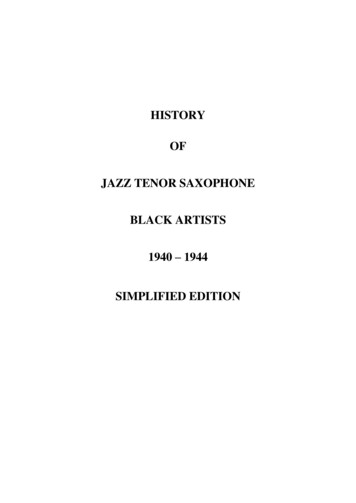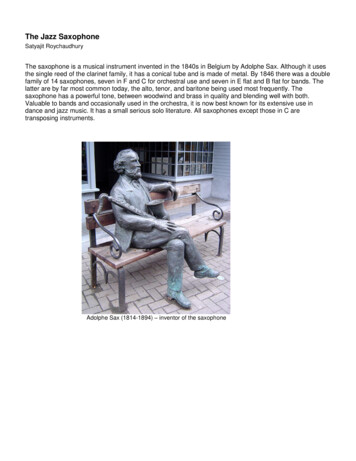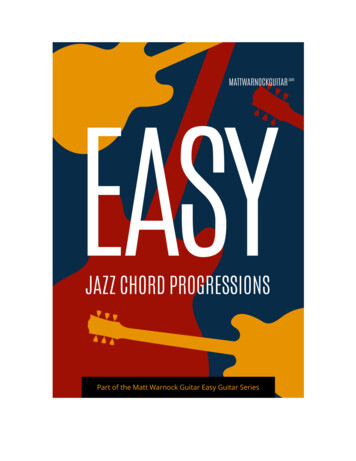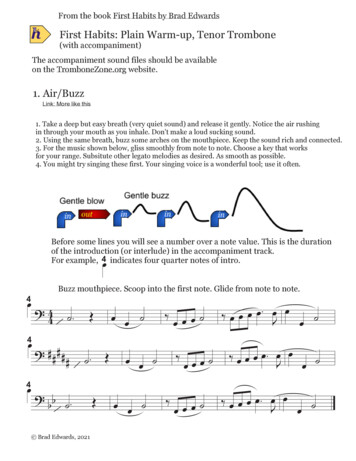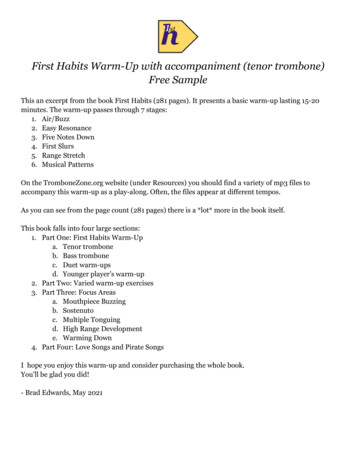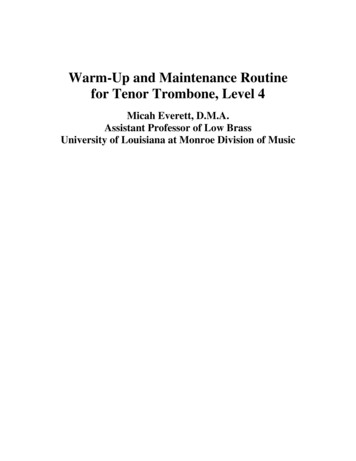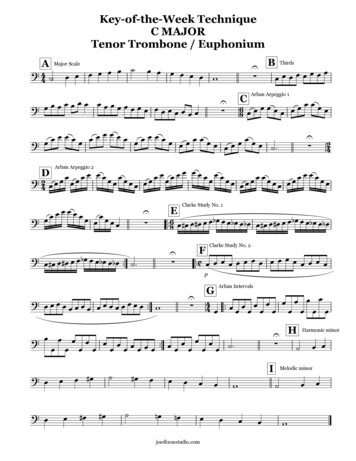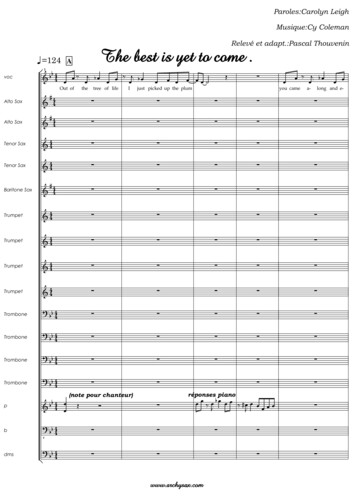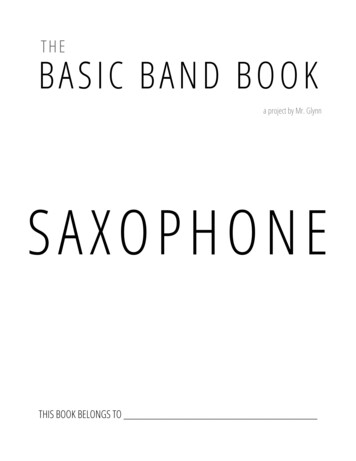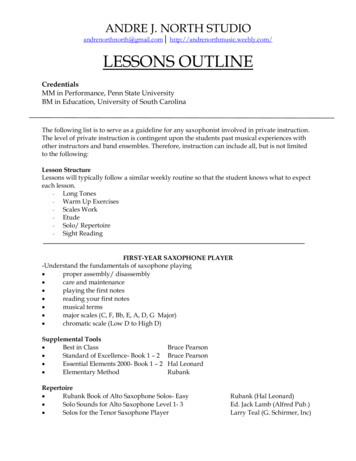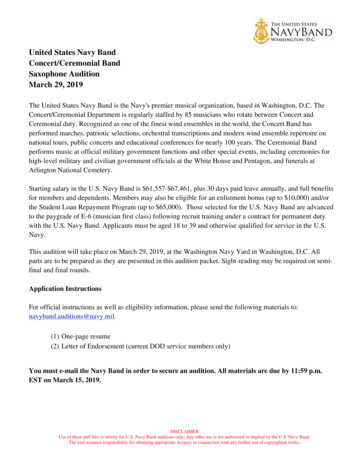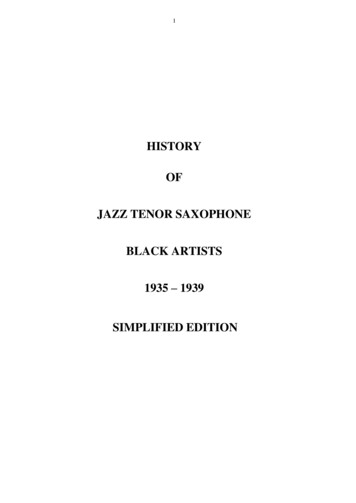
Transcription
1HISTORYOFJAZZ TENOR SAXOPHONEBLACK ARTISTS1935 – 1939SIMPLIFIED EDITION
2INTRODUCTION UPDATESIMPLIFIED EDITIONI have decided not to put on internet the ‘red’ Volume 2 in my Jazz Solographyseries on “The History of Jazz Tenor Saxophone – Black Artists 1935 – 1939”.Quite a lot of the main performers already have their own Jazz Archeology files.This volume will only have the remainders, and also auxiliary material like statusreports, chronology, summing ups, statistics, etc. are removed, to appear later inanother context. This will give better focus on the many good artists whonevertheless not belong to the most important ones.Jan EvensmoUpdated: Oct. 4, 2014, June 22, 2015June 10, 2014INTRODUCTIONORIGINAL EDITIONThe tenor saxophone of this volume represents the beginning of my addiction tojazz. When I was introduced to the subject by close friends in the late fifties andbecame a member of the Oslo Jazz Circle, this era was the main focus and the tenorsplayers its main attractions. Spending our pocket money on 78s from the U. S., westeadily accumulated fine collections of the famous bigbands and smallbandrecording groups. Much to our later grief and regret we even swapped our ownextremely rare Norwegian jazz heritage for Brunswicks and Vocalions!Our jazz paradigm was "competition"; the musicians were perceived competing witheach other in "cutting contests", and we, their faithful fans, consequently werecutting each other in "jazz knowledge". Every fortnight we had club meetings,highlighted by a jazz quizz which could be tough on newcomers. I remember thetime when I hardly could discern an altosax from a tenorsax and tried to hide thefact. However, the time came when Dick Wilson and Herschal Evans were easilyidentified after a few bars. It was also important to state and defend your opinion onwhy Evans was a "better" player than Wilson or vice versa. In our prime we were sogood that we collectively might have beaten any group of collectors quizzing in ourspecialties, and we challenged any authority with regard to our favourites andfavourite opinions. And the greatest pleasure was to have purchased an hithertounknown test pressing of an alternate take, then watching your friends' faceslistening to a magnificent tenorsax solo by one of the "great ones" for the first time!The dream of finding another worn broadcast acetate or unissued testpressing fromthe late thirties, featuring our immortal tenorsax favourites, never wane. Anydiscovery would work as a badly needed blood transfusion. After all, aren't we jazzmaniacs "brothers in blood" anyway? Honestly, if this book can produce a cassettefrom somewhere with a single tenorsax item not already listed, my time consumingefforts have been worth while.We lived in an era of myths. We learned that Chu Berry's final words before hepassed away in a car accident were "give me the tobacco purse"; the fact that he diedin a hospital without regaining consciousness never had any credibility here. Oneprominent club member even knew that small green men in spaceships had beencirculating the Earth for years, their main task to capture every single jazz note everplayed. One day, when we deserved it, they were going to land and give us this jazzwealth as token of friendship. I never quite believed this, but I hoped I was wrong.However, I personally came up with the idea of erecting a statue for the"unrecognized sideman", suggesting Chu as a proper candidate. The ideal site was a20 square metres rock in the fiord outside Molde, the city of the oldest existinginternational jazz festival, still going strong every year since 1961. The statue shouldbe ordinary man-sized with the horn pointing towards where the ferries were passingby with their festival guests only a few metres away! Before the necessary funds hadbeen collected, a more ambitious concept had however been created: The statueshould be modelled in size by the Statue of Liberty, with a big tenorsax instead of atorch, blowing warnings (taped from the Commodore "46 West 52" (take 1))whenever the fog became a danger to the maritime traffic in the fiord. The projecthad high priority for some time but was finally cancelled when a new airport wasbuilt outside Molde; the statue would have been in the middle of the ingoing aircraftcorridor. So much for that dream. But we might still erect a small statue .Jan EvensmoJanuary 15, 1997
3FLETCHER B. ALLENBorn: La Crosse, Michigan, July 25, 1905Died: Aug. 5, 1995To New York with Lloyd Scott's Band (1926), subsequently worked with Lloyd andCecil Scott in New York (1927). First recording session with Lloyd Scott, Jan. 10,1927 on (cl, as). Then joined Leon Abbey and sailed to Europe with Abbey inJanuary 1928. Recorded with Abbey on (cl, as, ts), Jan. 17, 1928, but the two itemswere rejected. Worked with Benny Peyton in Budapest 1929. Worked in Europeduring the 1930s. Recorded with Buddy Featherstonhaugh in England, Aug. 1 & 17,1933 on (cl, as). Toured with Louis Armstrong (including visit to Britain), andparticipates on (ts) in broadcasts from Copenhagen Oct. 21 and Stockholm Oct. 28,1933 with Armstrong, but no tenorsax soli. Worked in Paris with Freddy Taylor(1935):FREDDY TAYLOR AND HISSWING MEN FROM HARLEMParis, March 1935Freddy Taylor (tp, vo-77285), Charlie Johnson (tp), Chester Lanier (cl, as, bar),Fletcher Allen (cl, ts, arr), John Ferrier (p), Oscar M. Aleman (g), Eugened'Hellemmes (b), William Diemer (dm).Two items were recorded for Ultraphone, one has tenorsax:77285Blue DragSolo 16 bars. (M)Nice conception, a willingness to play, but technique seems to be a little behind,producing also a real fluff. Probably FT could play excellent tenorsax on luckyoccasions.Another session with FREDDY TAYLOR in Paris, April 1935 for Ultraphone wasrejected. Worked in India with Leon Abbey (1936). Led own band for long periods(including residency at Villa d'Este), worked with Benny Carter in Paris (early 1938)and recorded with Carter on (as), Paris, March 7, 1938. Recorded with own bandand Pierre Allier on (as) in Paris, March 15, 1938. Later joined WILLIE LEWIS torecord on (ts) in Paris, Dec. 1938, however, no tenorsax soli.Moved to Egypt with the Harlem Rhythmakers in late 1938. Returned to USA in1940, worked as a docker during World War II, later worked on baritone sax withvarious leaders in New York. His only recording session after the war is on (bar)with trumpeter Hal Mitchell in 1947. Worked with Fred "Taxi" Mitchell's Big Band(1970-71).HAROLD DIXON ARNOLDBorn: 1912Died: Chardon, Ohio, May 2, 2002Continued from 1931.MILLS BLUE RHYTHM BANDNYC. Feb. 11, 1937Charlie Shavers, Carl Warwick, Harry Edison (tp), Sandy Watson, Eli Robinson(tb), Tab Smith (as), Eddie Williams (cl, as), Ronald Haynes, Harold Arnold (ts),Billy Kyle (p), Danny Barker (g), John Williams (b), Lester Nichols (dm, vib),Chappie Willet (arr).Four sides were recorded for Vocalion/Variety, two have tenorsax:M-2-1Prelude To A StompSolo 14 bars. (FM)M-4-1Jungle MadnessSolo 16 bars. (FM)This is something else, compared to 1931 (if it really is HA with Hunter'sSerenaders)! HA has matured into a good tenorsaxophone player. He swings easilywith authority on both items, and particularly "Prelude ." is a notable piece ofmusic! This is the best of his MBRB sessions.BILLY KYLE AND HIS SWING CLUB BANDNYC. March 18, 1937Charlie Shavers(tp), Eddie Williams (cl), Tab Smith (as), Harold Arnold (ts), BillyKyle (p), Danny Barker (g), John Williams (b), O'Neil Spencer (dm), The PalmerBrothers (vo).Four sides were recorded for Vocalion/Variety, two have HA:M280-2Big Boy BlueBrief break. (FM)
4M281-1MargieSolo 8 bars. (F)M281-2MargieAs above. (F)Brief soli of quality. "Margie" is the fastest recording by HA, and it shows hecommands his horn. It is really unfortunate that he is so sparsely featured on thissession.MILLS BLUE RHYTHM BANDNYC. April 28, 1937Personnel as Feb. 11, 1937 except Alfred Cobbs (tb) and Ben Williams (cl, ts)replace Watson and Haynes.Four sides were recorded for Variety, two issued (and 430 existing), one hastenorsax:M429-1The Lucky SwingSolo 8 bars. (FM)A brief but promising solo.HENRY ALLEN AND HIS ORCHESTRANYC. April 29, 1937Henry Allen (tp, vo), Glyn Paque (cl), Tab Smith (as), Harold Arnold (ts), LuisRussell (p), Danny Barker (g), John Williams (b), Paul Barbarin (dm).Four titles were recorded for Vocalion, three have tenorsax:21070-1Sticks And StonesSolo 8 bars. (FM)21071-1Meet Me In The MoonlightSolo 10 bars. (SM)21072-1Don't You Care What Anyone Says?Solo 16 bars. (FM)NYC. June 19, 1937Similar personnel, possibly Charlie Holmes (as) replaces Smith.Four titles were recorded, three have tenorsax:21275-2Till The Clock Strikes Three21276-2The Merry-Go-Round Broke Down21278-1The Miller's Daughter, MarianneSolo 8 bars. (M)Soli 8 and 4 bars. (FM)Solo 16 bars. (M)Our best knowledge of HA is obtained through the two Henry Allen sessions. Heturns out to be a good, swinging saxophone player well above medium quality.Playing with a solid punch in a Chu-inspired style, with a pronounced vibrato, hecertainly has personality. All items have their merits, but I will highlight the groovy". Clock ." and ". Marianne".MILLS BLUE RHYTHM BANDPersonnel as April 28, 1937, Eli Robinson (arr-545).Four titles were recorded for Variety, one has HA:NYC. July 1, 1937M-545-1Solo 14 bars. (FM)Jammin' For The Jack-PotAlready the last HA item, a very unfortunate fact, because he really was able to"sing a song".No other recording sessions until 1980, when he accompanies Robert LockwoodJr. ("Hangin' On" - Rounder 2023).ULYSSES BANKS"BUDDY"Born: Dallas, Texas, Oct. 3, 1909Died: Desert Hot Springs, Sept. 7, 1991Commenced his professional career in California at the beginning of the thirties andat one time or another is said to have played with all of the west coast's finestorchestras. In 1933-34 with Charlie Echols' Band, later to be taken over by one ofthe band's trumpeters, Claude "Benno" Kennedy, later again by its altosaxistEmerson Scott, finally by Cee Pee Johnson through the early forties. However, UBis first heard on the following session:MAXINE SULLIVAN ACCOMPANIED BYHollywood, March 20, 1939Lloyd Reese (tp), Leo Trammel (cl), Floyd Turnham (as), Ulysses Banks (ts), EddieBeal (p), Red Callender (b), Oscar Bradley (dm), Claude Thornhill (arr-36051,54).Four titles were recorded for Victor, all have tenorsax:
536051-3I Dream Of Jeanie WithTLBHPart of intro. (SM)36053-9I'm Happy About The Whole ThingPart of intro.Obbligato. (SM)36054-5Drink To Me Only With Thine EyesPart of intro.Obbligato. (SM)36055-2Corn Pickin'Solo 8 bars. (M)Only tenorsax fragments, with the exception of "Corn .", still I do not hesitate tostate that UB is a very qualified performer in the Dick Wilson/Paul Bascombtradition. The brief solo on "Corn ." is evidence enough! UB is a tenorsax soloist Ireally wish had had the opportunity to record more in the thirties, I believe we havelost something of value.To be continued in 1943.PAUL BASCOMBBorn: Birmingham, Alabama, Feb. 12, 1910Died: Chicago, Illinois, Dec. 2, 1986One of the originators of the 'Bama State Collegians, which subsequently becamethe Erskine Hawkins Band. Whilst at college did some touring with the C. S. BeltonBand out of Florida, then worked regularly with 'Bama State Band, moved withthem to New York in 1934. Remained with Erskine Hawkins until 1944.ERSKINE HAWKINS AND HIS'BAMA STATE COLLEGIANSNYC. July 20, 1936Erskine Hawkins (tp, arr, dir), Wilbur Bascomb, Marcellus Green, Sam Lowe (tp),Edward Sims, Robert Range (tb), William Johnson (as), Jimmy Mitchelle (as, bar,vo), Paul Bascomb (ts), Heywood Henry (cl, bar), Avery Parrish (p), WilliamMcLemore (as, g), Leemie Stanfield (b), James Morrison (dm), Billy Daniels (vo).Four titles were recorded for Vocalion, two have tenorsax soli:19578It Was A Sad Night In Harlem19580I Can't Escape From YouSolo 16 bars. (S)Solo 30 bars. (SM)NYC. Sept. 8, 1936Same. Four titles were recorded, three have tenorsax:19822-1Swinging In Harlem19823-1Coquette19824-2Big John SpecialSolo 16 bars. (FM)Solo 8 bars. (M)Solo 32 bars. (FM)With the 'Bama State Collegians we meet one of the finest disciples of the ChuBerry tenorsax school. The first session offers two very professional and mature soliin the slow tempi, and particularly "I Can't Escape .", immortalized by DexterGordon almost a decade later, has the greatness of simplicity characterizing theimportant performers. Note the contrast of the bridge to the rest of the solo! Thesecond session has some promising efforts, but none quite successful, best is "BigJohn .", where some Dick Wilson-inspired phrasing is interesting.ERSKINE HAWKINS AND HIS'BAMA STATE COLLEGIANSNYC. April 19, 1937Same personnel. Four titles were recorded, three have tenorsax:21002-1'Way Down Upon The Swanee RiverSolo 16 bars. (M)21003-1Dear Old SouthlandSolo 16 bars. (M)21004-2Uproar ShoutSolo with orch 6 bars. (FM)Note: 21004-1, reported to be issued on LP, is aurally identical to the Vocalion 78rpm.NYC. Aug. 12, 1937Same. Four titles were recorded, two have tenorsax:21505-1Red CapSoli 4 and 4 bars. (M)
621507-1I Found A New BabySolo 14 bars. (F)1937Probably same personnel. Movie soundtrack. Only one title:Deviled HamSolo 16 bars. (F)NYC. Feb. 25, 1938Same. Merle Turner (vo-22472).Four titles were recorded, three have tenorsax:22471-1Carry Me Back To Old VirginiaSolo 16 bars. (FM)22472Let Me Day DreamSolo 4 bars. (SM)22474Lost In A ShuffleSolo 40 bars. (M)These sessions offer a variety of tenorsax performances in different tempi. Maybethere is a general lack of depth in the soli, particularly felt in the medium tempoitems which never really get into the top groove. The quite long solo on ". Shuffle"is, however, a proof of good craftmanship. More interesting, though, is the fast ".Ham" or particularly the brief pieces on "Red Cap", having some exquisite DickWilson-inspired phrases again (or maybe it was the other way around?).Although PB is said to have be
The tenor saxophone of this volume represents the beginning of my addiction to jazz. When I was introduced to the subject by close friends in the late fifties and became a member of the Oslo Jazz Circle, this era was the main focus and the tenors players its main attractions. Spending our pocket money on 78s from the U. S., we steadily accumulated fine collections of the famous bigbands and .
